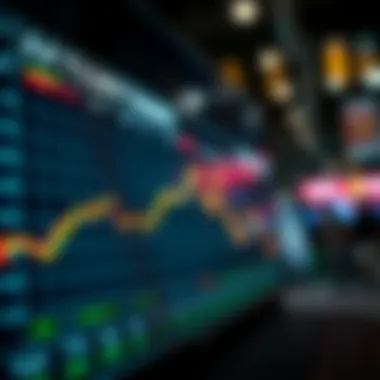Exploring the Dynamics of FTX Spot Margin Trading


Intro
The rise of cryptocurrency trading has shifted the landscape of financial markets, introducing a complexity that many investors are keen to understand. Among the myriad of trading options available, FTX spot margin trading stands out as a sophisticated method that combines the dynamics of margin trading with the straightforward nature of spot trading. This combination not only offers leverage for traders but also exposes them to a range of risks that require careful navigation. In this article, we’ll venture into the core elements of spot margin trading within the FTX ecosystem, dissecting its operational nuances while also shedding light on the broader cryptocurrency market trends that shape this trading style.
Understanding Cryptocurrency Market Trends
Current Market Analysis
As of now, the cryptocurrency market is experiencing unpredictable shifts. Bitcoin has been known to sway the tides, but emerging altcoins are also flexing their muscles. The actions of major players, including institutions and retail traders, often dictate market direction. During bull runs, it's common to see increased interest in margin trading as traders aim to capitalize on short-term price movements. Bear markets, conversely, heighten awareness of risk management since losses can mount quickly without proper strategies in place.
- Market Capitalization: The total market cap has seen extremes, fluctuating with news cycles and economic indicators.
- Trading Volume: Volume spikes often indicate potential price movements; thus, understanding these patterns is crucial for effective trading.
It is also critical to evaluate macroeconomic factors that can influence cryptocurrency sentiment, such as regulatory scrutiny or technological advancements within the blockchain space.
Historical Performance and Lessons Learned
History can be a guide in the volatile world of cryptocurrencies. Take the 2017 bull run, for example. Many traders leveraged margin, hoping to maximize profits, only to be caught off guard during the subsequent bear market. Such events underscore the importance of understanding market cycles and how swiftly things can turn. Learning from these experiences is vital.
"In trading and investing, what is comfortable is rarely profitable." - Robert Arnott
Novice traders should study past events, such as the rise and fall of Bitcoin and notable altcoins, to glean insights about trends and sentiment that can recur. Understanding past mistakes made during euphoric market conditions can save traders from potential pitfalls.
Practical Guides for Crypto Investors
Step-by-Step Trading Strategies
If you're diving into FTX spot margin trading, having a plan is essential. Here's a straightforward guide to get you started:
- Get Familiar with FTX: Create an account, familiarizing yourself with the interface and tools available.
- Know Your Market: Analyze both technical and fundamental aspects of the assets you're interested in. Staying updated through resources like CoinMarketCap can be helpful.
- Set Up Your Wallet: Ensure that you have a secure wallet for your assets. This safeguards against potential exchange breaches.
- Choose Your Trading Pairs: FTX offers a range of trading pairs. Select those that align with your market insights and trading strategy.
- Understand Leverage: Determine the extent of leverage you are comfortable with based on your risk tolerance.
- Execute Your Trades: Start executing trades, keeping your risk parameters in check.
Risk Management Techniques
Effective risk management can mean the difference between profit and loss in trading. Here are some techniques to consider:
- Diversification: Don’t put all your eggs in one basket. Spread your investments across multiple cryptocurrencies.
- Use Stop-Loss Orders: Setting stop-loss levels can help protect your capital by automatically selling at a predetermined price.
- Monitor Market Sentiment: Tools like Reddit provide community sentiment that can influence market movement.
- Periodic Review: Regularly review and reassess your trading strategies. What worked last month may not work next month.
By honing these strategies, both novice and experienced investors can better navigate the challenging waters of FTX spot margin trading, making informed decisions that align with their overall investment goals.
Foreword to FTX and Margin Trading
Margin trading has emerged as a crucial strategy for investors aiming to amplify their trading positions while navigating the volatile realms of cryptocurrency markets. Understanding this concept within the context of the FTX exchange is paramount for traders, whether you're a seasoned veteran or just stepping into the world of crypto. FTX has gained significant traction over the years for its user-friendly interface and innovative offerings, making it a noteworthy player in the industry.
The importance of this topic lies in its ability to shed light on the complex dynamics of margin trading. In an environment where price swings can feel like a rollercoaster ride, grasping the advantages and risks of margin trading on FTX can enhance a trader’s decision-making process. By leveraging borrowed assets, traders can open positions that far exceed their actual capital, upping the ante significantly.
However, along with potential higher returns comes the caveat of equally higher risks. When you trade on margin, you’re not just walking a tightrope; you’re balancing on it. Understanding how margin calls work, the implications of liquidation, and how FTX structures its margin trading can equip traders with essential knowledge to avoid pitfalls. Thus, this article traverses through the intricacies of FTX and margin trading, catering to the need for clarity in an otherwise confusing subject.
Overview of FTX Exchange
FTX Exchange has made its mark as an innovative cryptocurrency trading platform, offering a broad range of financial products beyond conventional spot trading. Launched in 2019, it has garnered attention for its robust infrastructure and user-focused features. From derivatives trading to tokenized stocks, FTX positions itself as a versatile exchange catering to diverse investment strategies.
One of FTX's standout features is its focus on user experience. With a sleek interface, traders can navigate the complexities of the crypto landscape with relative ease. Furthermore, FTX boasts deep liquidity and efficient order execution, making it a preferred choice among institutional players as well as retail investors. It also incorporates advanced functionalities like algorithmic trading and listing of new tokens, fostering a dynamic trading environment where flexibility is key.
Importantly, FTX has made strides in addressing regulatory concerns, ensuring compliance with varying global standards. It has significantly broadened its reach, with offerings in multiple jurisdictions, allowing traders from different backgrounds to engage with its platform securely.
Understanding Margin Trading
Margin trading is fundamentally about leveraging borrowed capital to enhance potential returns on investments. In simpler terms, it’s like using a loan to buy more assets than you can afford with your own money, leading to the possibility of greater profits, but also greater losses.
In the context of FTX, margin trading allows users to borrow from the exchange, using their current holdings as collateral. This means traders can open larger positions without needing to have the full amount in their wallets. With this opportunity, traders can amplify their returns significantly. However, they must also be aware that losses are also amplified, making precise risk management crucial.


The mechanics vary across exchanges, but generally, margin trading involves the following key elements:
- Collateral: The assets that are held as a guarantee against the borrowed amount.
- Leverage: The ratio of borrowed funds to your own investment. Common FTX leverage options range from 2x to 20x, depending on the asset.
- Margin Calls and Liquidation: If the value of the collateral drops too low, traders might receive a margin call, needing to deposit more funds to maintain their position.
Ultimately, understanding these aspects of margin trading empowers traders to wield the tools available on FTX effectively, enabling them to exploit market fluctuations while managing their risks adequately.
"Margin trading is not for the faint of heart – when trading with borrowed money, a clear understanding of risks is non-negotiable."
As traders prepare to engage in margin trading, they must arm themselves with the knowledge and tactics needed to navigate the waters of FTX confidently, ensuring that they strike the right balance between risk and reward.
Mechanics of Spot Margin Trading on FTX
Understanding the mechanics of spot margin trading on FTX is crucial for anyone looking to navigate the rapidly shifting waters of cryptocurrency trading. This section demystifies how margin trading functions within the FTX ecosystem, focusing on specific elements, their benefits, and considerations.
Spot margin trading allows traders to borrow funds in order to increase their market exposure, effectively leveraging their positions. This means that even if a trader has a limited amount of capital, they can control a significantly larger position in the market. Such a mechanism creates not just opportunities for increased profits, but also escalates the risks involved in trading.
Because the margin trading environment can be complex, understanding its inner workings is key to making informed decisions. Given the potential for gain, the nuances of how these transactions function often get overlooked, leading to missed opportunities or even substantial losses.
How Spot Margin Trading Works
Spot margin trading on FTX involves trading in cryptocurrency at a certain price while also utilizing borrowed funds. At its core, the mechanics are simple: traders post collateral to secure a loan and subsequently trade with borrowed assets. This allows for amplified buying power, enabling individuals to engage more significantly in the market while only risking a portion of their actual capital.
- Collateral Posting: To begin, a trader must deposit a certain amount of cryptocurrency or fiat as collateral.
- Borrowing Funds: Once collateral is in place, the trader can access borrowed funds, which can vastly increase their position in the market.
- Buying Assets: Using these funds, a trader can purchase additional assets without needing to have the full capital upfront.
- Managing Positions: As market conditions change, the trader must attentively manage their positions to safeguard against liquidations—a process whereby the exchange automatically closes positions to cover losses.
This trade-off between risk and reward is what makes spot margin trading both alluring and perilous.
Key Features of FTX Spot Margin Trading
The key features of spot margin trading on FTX give it an edge over various other trading platforms. Recognizing these unique characteristics can aid traders in optimizing their trading strategies.
Leverage Options
Leverage is a hallmark of margin trading. By allowing traders to control a larger position than what their initial capital would permit, leverage can significantly amplify potential gains. Typically, FTX offers various leverage levels for its traders, catering to different risk appetites. For instance, with a 10x leverage option, a trader could control $10,000 worth of assets with only $1,000 of their own capital. \n
- Key Characteristic: Flexibility in leverage settings enables traders to tailor their risk exposure. A cautious trader can opt for lower leverage while risk-seeking individuals might choose higher.
- Advantages: Higher leverage can lead to more substantial returns; however, it can also mean greater losses if the market moves unfavorably.
Order Types
Navigating different types of orders is essential when trading on FTX. Each order type serves a specific function—whether to buy, sell, limit, or market—allowing traders to tailor their strategies.
- Key Characteristic: FTX provides options such as market orders, limit orders, and stop orders. This flexibility can be beneficial for executing precise trading strategies.
- Advantages: Using limit orders allows traders to buy or sell at a predetermined price, thereby managing entry and exit points effectively. On the contrary, market orders execute immediately but could subject traders to unfavorable price fluctuations due to slippage.
Interest Rates on Borrowed Assets
Interest rates on borrowed assets pose another critical aspect of spot margin trading on FTX. When utilizing borrowed funds, it's essential to understand that traders will incur interest charges on the capital borrowed.
- Key Characteristic: These rates can vary across different assets and fluctuate based on market conditions.
- Advantages: Understanding the cost of borrowing helps traders to assess the total expenditure related to their trading strategies, allowing for more informed financial planning.
In summation, the mechanics of spot margin trading on FTX manifest through its leverage options, diverse order types, and the financial considerations of interest rates. These elements not only influence how traders interact with the market but also how they balance the inherent risks associated with margin trading. By grasping these intricacies, traders position themselves to make calculated decisions in an otherwise tumultuous environment.
"The finer your understanding of margin trading mechanics, the better equipped you'll be to chart your course wisely in this volatile seas of cryptocurrency."
For further information on trading strategies and understanding market dynamics, consider visiting CoinMarketCap or Investopedia.
Advantages of FTX Spot Margin Trading
Spot margin trading on FTX offers a range of advantages that can significantly enhance a trader's experience and opportunities. It empowers investors to venture beyond mere trade execution, enabling a more nuanced approach to capitalizing on market dynamics. By understanding these benefits, traders can make informed decisions that leverage their trading capacity and adapt to changing market conditions effectively.
Increased Trading Capacity
Increased trading capacity is one of the prime advantages of spot margin trading. By using borrowed funds to amplify the size of their trades, traders on FTX can maximize their potential returns without necessarily increasing their capital investment. This leverage, particularly in the highly volatile cryptocurrency markets, means that even small movements in asset prices can lead to significant profit—or loss.


For instance, if a trader has $1,000 and uses a 5x leverage, they effectively control $5,000 in assets. This larger position can allow an individual to capture greater profit opportunities than they would have with just their initial investment. However, it's crucial to recognize that while leverage increases potential returns, it similarly magnifies risks. A trader must be cautious not to get in over their head.
In essence, understanding one's risk tolerance and market conditions becomes vital in harnessing the increased trading capacity effectively.
Profiting from Market Volatility
Market volatility can be both a boon and a bane, but for margin traders on FTX, profiting from market volatility can be incredibly rewarding. In a market that changes faster than a cat can lick its ear, traders have the opportunity to capitalize on both upward and downward price movements.
For example, suppose Bitcoin swings between $50,000 and $55,000 over a short period. A trader who anticipates that volatility can take advantage of movements by going long on Bitcoin when prices are low and then shorting at the peak, all while employing margin. This strategy can lead to profitable trades on both sides of the market.
FTX offers various tools and features, such as stop-loss orders and limit orders, that help navigate these volatile waters. These features enable traders to set predetermined exit points for their trades, minimizing potential losses while maximizing profit opportunities. Thus, savvy margin traders can leverage this volatility to create a profitable trading strategy.
Access to Diverse Trading Strategies
With access to diverse trading strategies, FTX spot margin trading allows users to implement complex trading approaches, aligning their tactics with individual goals and market conditions. From arbitrage strategies to hedging and spread trading, the options are extensive.
Investors can use margin to diversify their portfolios more easily. For example, a trader may allocate borrowed funds to explore lesser-known altcoins, which could have significant growth potential. By diversifying, traders can spread their risk across various assets, enhancing their chances of securing returns, even in a market downturn.
Moreover, traders can also combine different strategies or take more significant positions based on their risk appetite and market predictions. Having the flexibility to use borrowed funds can inspire innovative strategies that wouldn’t be feasible using only one’s capital.
In today's fast-paced trading environment, understanding the advantages of using margin effectively can be the edge that distinguishes profitable traders from the rest.
Risks and Challenges of Spot Margin Trading
Spot margin trading, while offering the promise of amplified returns, also presents a slew of risks and challenges that traders must navigate. Understanding these risks is crucial for anyone looking to step into this high-octane trading environment. It’s not just about the allure of higher leverage; traders must also think critically about potential pitfalls that could lead to unfavourable outcomes.
Market Volatility and Liquidation Risks
Market volatility is the bread and butter of trading, but it dances a dangerous tango when it comes to margin trading. Volatility can cause rapid market swings, leading to significant gains or painful losses in a matter of seconds. When prices dip unexpectedly, the assets bought on margin may plummet, triggering margin calls from the exchange.
Liquidation risks become prominent here. If the value of a trader’s equity falls below a certain threshold, the exchange may liquidate their position to recover funds lent for margin trading. This means that even a momentary market shift can wipe out an entire position, leaving traders devastated. It’s like jumping into a cold pool; the shock can take your breath away.
Important Note: A solid understanding of market conditions and implementing strategies like stop-loss orders can help mitigate these risks, enabling traders to safeguard their investments.
Interest and Repayment Obligations
Taking on borrowed assets isn’t free. Interest accrues on the amount borrowed to finance margin trading activities, and traders must remain aware of how these obligations can eat into potential profits. Interest rates on borrowed funds differ between exchanges and can fluctuate based on market conditions. Therefore, careful attention to these rates is essential before diving into a position.
Repayment obligations add another layer to the complexity. If markets swing unfavorably, traders not only face the loss of their initial investment but also the obligation to repay borrowings, often exacerbating losses. Not staying on top of repayment schedules might result in additional fees or penalties, further complicating the financial landscape of margin trading. Hence, understanding the terms of borrowing on platforms like FTX becomes crucial to avoid pitfalls.
Regulatory Considerations
Global Regulatory Landscape
The global regulatory landscape surrounding margin trading varies widely between jurisdictions. Regulations aim to protect investors while ensuring a fair trading environment. Each country has its unique approach to governing trading practices, leading traders to tread carefully as they navigate these waters.
For instance, the requirements in jurisdictions such as the European Union may differ substantially from those in Asia or North America. Specific characteristics of this landscape include limited leverage ratios and stringent reporting requirements designed to enhance transparency. Such regulations can be both beneficial and challenging, providing safeguards while potentially restricting trading flexibility.
Traders should consider these regulations when trading on platforms like FTX, as non-compliance can lead to severe penalties or loss of access to certain trading features.
Compliance Issues
Compliance issues can be a tangled web for traders involved in margin trading. Since regulatory frameworks are ever-evolving, staying updated on compliance requirements is crucial for avoiding unintended breaches. Notably, exchanges like FTX may implement specific protocols to ensure all trading activities align with local regulations.
A key characteristic of compliance is its focus on anti-money laundering (AML) measures and know-your-customer (KYC) guidelines that exchanges enforce. While this drives greater trust among investors, it also poses challenges for traders who might find the paperwork cumbersome and time-consuming. Navigating these requirements may take time, but it’s a necessary evil to protect the integrity of the trading environment.
Ultimately, compliance ensures a stable trading atmosphere, but its complexities require diligence from traders to avoid pitfalls that can lead to significant legal repercussions.
Comparison with Other Trading Platforms
In today's fast-paced trading environment, discerning the differences among platforms is paramount for both novice and seasoned investors. The landscape of cryptocurrency trading is rife with options, but understanding how FTX stands in relation to other platforms can create pathways to smarter trading strategies. This section dives into key differences and benefits, ensuring traders can make informed decisions about where to allocate their resources.


FTX vs. Binance: A Margin Trading Perspective
Both FTX and Binance have carved out significant niches in the crypto trading ecosystem, yet they are not without their distinctions. FTX is particularly known for a streamlined interface and specialized tools tailored for derivatives and margin trading. This allows traders to use leverage effectively, enhancing their potential returns.
In contrast, Binance boasts a broader array of coins and extensive liquidity, which can appeal to traders seeking diverse opportunities. However, the complexity of Binance's platform might deter beginners who prefer the straightforward approach of FTX.
- User Interface: FTX's interface is designed with margin traders in mind, focusing on essential tools without overwhelming the user. Binance, though powerful, may have a steeper learning curve for those venturing into margin trading.
- Leverage Options: FTX offers flexible leverage settings, allowing users to fine-tune their risk exposure. Binance's leverage can also be competitive, but it’s worth noting that their margin trading features are primarily intertwined with their broader platform, which can complicate execution.
- Fee Structures: Unfortunately, trading fees are ubiquitous in this arena. FTX has a transparent fee model that’s attractive for traders engaged in higher volumes. Binance can tout lower fees at times, but unclear structures can leave users puzzled about actual costs.
Ultimately, the choice between FTX and Binance hinges on individual trading goals, coin preferences, and comfort with platform complexity. It’s advisable that trader’s weigh these factors according to their strategies before diving into the market.
Marginal Differences with Traditional Exchanges
When juxtaposing FTX's spot margin trading framework with traditional exchanges, the differences become striking. Traditional exchanges, often rigid in their offerings, usually provide limited options for margin and leverage. Such constraints might leave sophisticated traders feeling boxed in.
Considerations include:
- Flexibility in Trading: Traditional exchanges generally don't offer the agile trading options available on platforms like FTX. Spot margin trading on FTX allows traders to swiftly capture market movements without the restrictions seen elsewhere.
- Asset Availability: Traditional exchanges often come with a set menu of assets, which may not cater to emerging market trends or less mainstream cryptocurrencies. FTX, on the other hand, typically embraces a wider selection, affording traders access to innovative trading possibilities.
- Market Tools: FTX comes equipped with cutting-edge tools designed for serious traders. Features like spot margin trading, options trading, and others are not just add-ons; they enhance the trading experience holistically. Traditional exchanges might offer tools but often lack the depth necessary for high-frequency or sophisticated trading strategies.
- User Experience: Finally, while traditional exchanges may offer stable, tried-and-true environments, they don't always keep pace with the evolving expectations of today’s tech-savvy traders. FTX emphasizes speed, efficiency, and reliability, which align more closely with modern trading paradigms.
In summary, while traditional exchanges provide a familiar foundation for many, platforms like FTX are redefining the standards of margin trading. Those looking to capitalize on the intricacies of financial markets may find themselves drawn towards the flexibility and technological advancements FTX has to offer.
Understanding these comparisons aids traders in selecting the right platform that fits their unique style, risk tolerance, and market engagement.
Best Practices for Successful Spot Margin Trading
Successful trading, particularly in the realm of spot margin, requires not just knowledge, but also a set of best practices that can guide traders through the complex landscape of cryptocurrencies. This section sheds light on the critical elements needed to navigate FTX spot margin trading effectively, covering risk management, strategic entry and exit points, and the importance of ongoing market analysis. By adopting these best practices, traders can minimize risks while enhancing their potential for profit.
Essential Risk Management Techniques
When it comes to margin trading, risks can escalate quickly. Proper risk management isn’t just helpful; it’s a necessity. One of the first steps is to determine your risk tolerance before you even place a trade. Here are several techniques worth considering:
- Position Sizing: Consider how much capital you're willing to risk on each trade. Generally speaking, trading less than 2% of your total capital on a single trade is a good benchmark to follow.
- Stop-Loss Orders: Setting stop-loss points can safeguard against significant losses. They tell the platform to exit the trade if the asset's price declines to a certain level.
- Diversification: Don't put all your eggs in one basket. Spreading investments across varied assets can help mitigate the risk inherent in margin trading.
"Risk management is the cornerstone of any trading strategy; without it, success is just a stroke of luck."
Strategic Entry and Exit Points
Identifying the right moments to enter and exit trades can significantly impact profitability. Timing is everything in the volatile world of margin trading. Consider a few strategies:
- Technical Analysis: Utilize charts and indicators to pinpoint trends. Look for patterns in the market that have historically indicated price movements. For instance, if you notice a head and shoulders pattern forming, it may be a clue to exit.
- Market News: Keeping an eye on market news can provide context for price movements. Sudden news can change market sentiment, leading to price spikes or drops, influencing your entry and exit timing.
- Limit and Market Orders: Decide when to use limit orders versus market orders. Limit orders allow for better control over entry and exit prices. Market orders can be beneficial for quick entries or exits but can sometimes come at a higher price.
Ongoing Market Analysis
The world of cryptocurrency is always changing. Ignoring ongoing market analysis can prove detrimental. Regular reviews help to keep your strategies aligned with current market conditions. Important components include:
- Trend Analysis: Continually assess the market trends. Are prices moving up, down, or sideways? Knowing the overall trend can inform your trading decisions.
- Volume Analysis: Monitoring trading volume can offer insights into price movement strengths. A price change accompanied by high volume may imply stronger momentum.
- Sentiment Analysis: Keep an eye on what traders are saying in various forums. Platforms like reddit.com often showcase trader sentiment, which can be a leading indicator of market movement.
In essence, effective spot margin trading on FTX comes down to safeguarding your capital, knowing when to get in and out, and staying sharp on market movements. Those who commit to proper practices are more likely to find success in this complex trading environment.
Epilogue: The Future of Spot Margin Trading on FTX
In the ever-evolving landscape of cryptocurrency trading, the future of spot margin trading on FTX is both promising and complex. As investors and traders look to optimize their strategies, understanding the trajectory of margin trading becomes crucial. This section delves into key elements—such as technological advancements and market shifts—that shape the future landscape of margin trading on this vibrant exchange.
Technological Advancements
The realm of financial trading is not immune to the impact of rapid technological growth. FTX's commitment to integrating cutting-edge technology plays a significant role in enhancing the user experience and overall efficiency of spot margin trading. The rise of artificial intelligence and machine learning is particularly noteworthy. These tools empower traders to analyze vast datasets, enabling them to predict market movements more accurately.
For instance, automated trading bots can execute trades at lightning speed, harnessing favorable market conditions that might otherwise be missed by a human trader. Additionally, improvements in API integrations allow for seamless connectivity between various trading platforms, creating an accessible ecosystem for users who wish to exploit multiple trading opportunities simultaneously. As FTX continues adapting to these advancements, it positions itself as a crucial player in the crypto margin trading arena.
Market Trends and Predictions
Keeping a finger on the pulse of market trends is essential for anyone engaged in trading, particularly in the volatile world of cryptocurrencies. Current trends indicate a growing acceptance of margin trading among different classes of investors, including institutional players who are increasingly drawn to the potential for enhanced returns. This shift is likely to lead to a more stabilized market, as larger investments under a margin trading framework can dilute the erratic price swings commonly associated with smaller, retail-driven transactions.
Predicting how these trends will play out is not an easy task, but several indicators suggest that margin trading is headed toward a more regulated and transparent framework. Regulatory bodies are starting to take a keen interest in the practices of exchanges like FTX. Compliance measures may become stricter, with an emphasis on protecting traders and fostering trust within the market.
Moreover, as the global economy continues to adapt to digital currencies, it’s anticipated that there's going to be more robust frameworks governing cryptocurrency exchanges. This means that margin trading, while inherently risky, may operate within safer boundaries, encouraging more cautious participation from investors.
"Understanding the future of margin trading isn't just about new tools and technologies—it's about how these elements interact with an ever-shifting market landscape."















